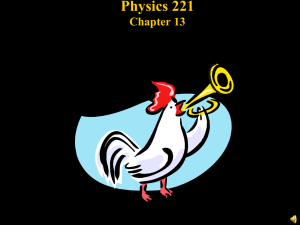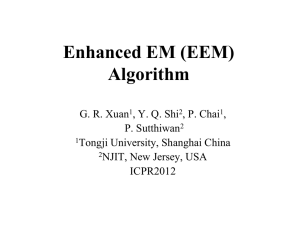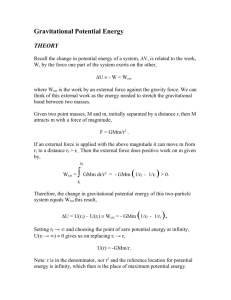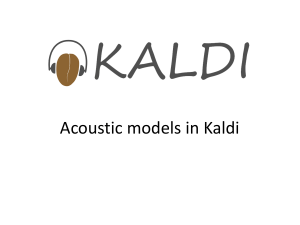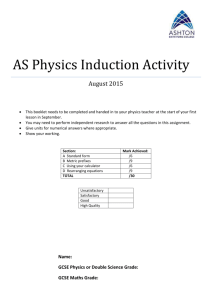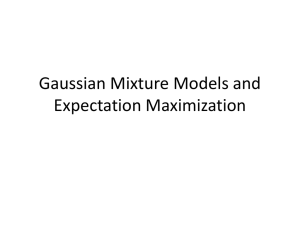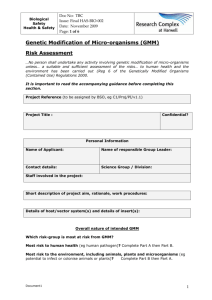2. GMM Tokenization - Michigan State University
advertisement
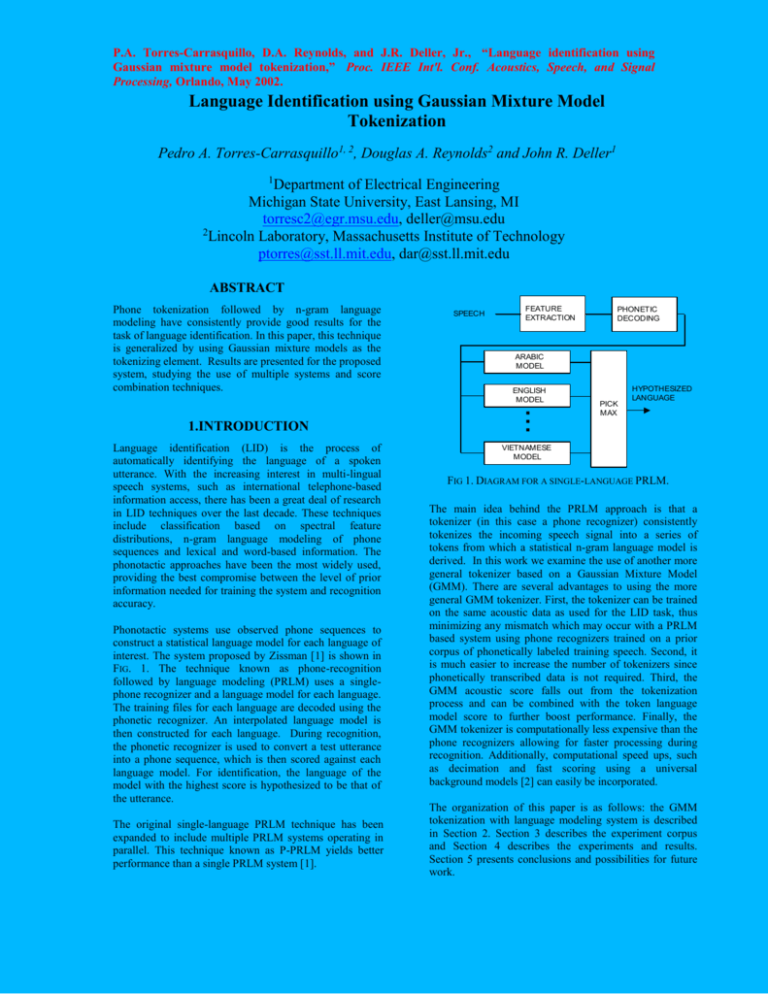
P.A. Torres-Carrasquillo, D.A. Reynolds, and J.R. Deller, Jr., “Language identification using Gaussian mixture model tokenization,” Proc. IEEE Int'l. Conf. Acoustics, Speech, and Signal Processing, Orlando, May 2002. Language Identification using Gaussian Mixture Model Tokenization Pedro A. Torres-Carrasquillo1, 2, Douglas A. Reynolds2 and John R. Deller1 1 Department of Electrical Engineering Michigan State University, East Lansing, MI torresc2@egr.msu.edu, deller@msu.edu 2 Lincoln Laboratory, Massachusetts Institute of Technology ptorres@sst.ll.mit.edu, dar@sst.ll.mit.edu ABSTRACT 1.INTRODUCTION Language identification (LID) is the process of automatically identifying the language of a spoken utterance. With the increasing interest in multi-lingual speech systems, such as international telephone-based information access, there has been a great deal of research in LID techniques over the last decade. These techniques include classification based on spectral feature distributions, n-gram language modeling of phone sequences and lexical and word-based information. The phonotactic approaches have been the most widely used, providing the best compromise between the level of prior information needed for training the system and recognition accuracy. Phonotactic systems use observed phone sequences to construct a statistical language model for each language of interest. The system proposed by Zissman [1] is shown in FIG. 1. The technique known as phone-recognition followed by language modeling (PRLM) uses a singlephone recognizer and a language model for each language. The training files for each language are decoded using the phonetic recognizer. An interpolated language model is then constructed for each language. During recognition, the phonetic recognizer is used to convert a test utterance into a phone sequence, which is then scored against each language model. For identification, the language of the model with the highest score is hypothesized to be that of the utterance. The original single-language PRLM technique has been expanded to include multiple PRLM systems operating in parallel. This technique known as P-PRLM yields better performance than a single PRLM system [1]. SPEECH FEATURE EXTRACTION PHONETIC DECODING ARABIC MODEL ENGLISH MODEL ... Phone tokenization followed by n-gram language modeling have consistently provide good results for the task of language identification. In this paper, this technique is generalized by using Gaussian mixture models as the tokenizing element. Results are presented for the proposed system, studying the use of multiple systems and score combination techniques. PICK MAX HYPOTHESIZED LANGUAGE VIETNAMESE MODEL FIG 1. DIAGRAM FOR A SINGLE-LANGUAGE PRLM. The main idea behind the PRLM approach is that a tokenizer (in this case a phone recognizer) consistently tokenizes the incoming speech signal into a series of tokens from which a statistical n-gram language model is derived. In this work we examine the use of another more general tokenizer based on a Gaussian Mixture Model (GMM). There are several advantages to using the more general GMM tokenizer. First, the tokenizer can be trained on the same acoustic data as used for the LID task, thus minimizing any mismatch which may occur with a PRLM based system using phone recognizers trained on a prior corpus of phonetically labeled training speech. Second, it is much easier to increase the number of tokenizers since phonetically transcribed data is not required. Third, the GMM acoustic score falls out from the tokenization process and can be combined with the token language model score to further boost performance. Finally, the GMM tokenizer is computationally less expensive than the phone recognizers allowing for faster processing during recognition. Additionally, computational speed ups, such as decimation and fast scoring using a universal background models [2] can easily be incorporated. The organization of this paper is as follows: the GMM tokenization with language modeling system is described in Section 2. Section 3 describes the experiment corpus and Section 4 describes the experiments and results. Section 5 presents conclusions and possibilities for future work. P.A. Torres-Carrasquillo, D.A. Reynolds, and J.R. Deller, Jr., “Language identification using Gaussian mixture model tokenization,” Proc. IEEE Int'l. Conf. Acoustics, Speech, and Signal Processing, Orlando, May 2002. 2. GMM Tokenization A diagram of the proposed system is shown in FIG. 2. The major components of the proposed system are a GMM tokenizer and a language model for each language of interest. Additionally a Gaussian classifier can be used to jointly combine the language model scores (the backend classifier). Similar to the phone tokenizer in the PRLM system, the GMM tokenizer is trained on just one language but is used to decode information for any candidate language. The GMM is used to construct an acoustic dictionary of the training language. The decoded sequence is then used to train the language models. FEATURE EXTRACTION SPEECH ARABIC MODEL ... ENGLISH MODEL VIETNAMESE MODEL GMM TOKENIZER C L A S S I F I E R HYPOTHESIZED LANGUAGE FIG 2. DIAGRAM FOR LID SYSTEM BASED ON TOKENIZATION AND LANGUAGE MODELING. Initially some techniques for conditioning the tokenizer output were studied. These techniques hoped to include long-term speech information, but these techniques tend to result in decreased system performance. These techniques included run-length coding, multigrams [4] and vector quantization. 2.3. Backend classifier A Gaussian “backend” classifier is used to further assess the discriminatory characteristics of the language model scores. For a single GMM tokenizer and L languages of interest, an L dimension vector of language model scores is produced for each input frame. The input vectors to this classifier are normalized using linear discriminant analysis5. The purposes of this normalization scheme are twofold. First, this process decorrelates the information obtained from the system when multiple tokenizers are used. Second, it provides a dimension reduction of the input vector that results in a more reliable classifier. In the experiments described below, diagonal covariance matrices are used. 3. SPEECH CORPUS GMM 2.1.GMM tokenizer The GMM tokenizer assigns incoming feature vectors to partitions of the acoustic space. During training, speech is first processed by a feature extraction system that computes a vector of mel-warped cepstral parameters every 10 ms (100 per second). The feature vector is created using the first ten cepstral parameters and delta-cepstra between two successive and two prior frames. The cepstral vectors are processed through a RASTA filter to remove linear channel effects. Next these features vectors are used to train a GMM. During testing, speech is decoded frame by frame. For each frame, the tokenizer outputs the index of the Gaussian component scoring highest in the GMM computation. A subset of the Linguistic Data Consortium “CallFriend” corpus was used to evaluate the system [6]. The CallFriend corpus consists of unscripted conversations in various languages captured over domestic telephone lines. The particular subset of the CallFriend corpus used in these experiments was the same as that used for the 1996 NIST language recognition evaluation. The training set of the corpus consists of 20 telephone conversations from each of 12 languages lasting approximately 30 minutes each. The development set consists of 1184 30-second utterances and the evaluation set of the corpus consists of 1492 30-second utterances, each distributed among the various languages of interest. The corpus includes speech in the following 12 languages: Arabic, English, Farsi, French, German, Hindi, Japanese, Korean, Mandarin, Spanish, Tamil and Vietnamese languages. The training set of the corpus is used to train both the GMM tokenizers and the language models. The development set of the corpus is used to train the backend classifier and the evaluation set is used to test the full system. 4. EXPERIMENTS 2.2. Language modeling The language-modeling component of the proposed system is an interpolated bigram model [3], which is governed by the probability relation. Pˆ (a | b) 2 P(a | b) 1 P(a) 0 (1) The main experiments are designed to study the effect of elements such as mixture model order, the use of a backend classifier for both single tokenizer and multiple tokenizer systems and the combination of language model scores with acoustic likelihoods. Twelve-way closed set identification is the task in all experiments. 4.1. Single tokenizer where a and b represent consecutive indexes obtained from the tokenizer output. The weights are set to 2 = 0.666, 1 = 0.333 and 0 = 0.001. The first experiment studies the effect of the GMM order on the error rate. Results are presented for model orders 64, 128, 256 and 512. Orders above 512 were not studied because of insufficient training data for properly training P.A. Torres-Carrasquillo, D.A. Reynolds, and J.R. Deller, Jr., “Language identification using Gaussian mixture model tokenization,” Proc. IEEE Int'l. Conf. Acoustics, Speech, and Signal Processing, Orlando, May 2002. From the plot we see that performance improves with increasing model order but with diminishing returns. It is also clear that the use of the backend classifier provides a large and consistent improvement for all mixture orders. This is consistent with results obtained with the PPRLM system [1]. The best average error rate obtained is 38.1% for a 512-order GMM system. 80 75 70 Error rate 65 60 ARABIC-BASED SYSTEM SPEECH ENGLISH-BASED SYSTEM ... the language models. This experiment also assesses the effect of using a Gaussian classifier for combining the language model scores. FIG. 3 shows the relation between model order and average error rate. The average error rate is computed over all 12 tokenizers for each model order. The dashed line in the figure is the average error ate without the use of a back-end Gaussian classifier. The solid line is the average error rate when using a back-end Gaussian classifier. VIETNAMESEBASED SYSTEM C l a s s i f i e r HYPOTHESIZED LANGUAGE FIG 4. PARALLEL GMM TOKENIZATION SYSTEM. Similarly to the method employed in P-PRLM, each system tokenizer is trained using speech from only a single language. The language models for each tokenization system are trained using the training set of the CallFriend corpus. The plot in FIG. 5 presents the average error rate as a function of the number of tokenization systems, N, with N ranging from 1 to 12. The diagram also includes curves for the best and worst performing cases for each set of systems. The 12-tokenizer system results in a 36.3% error rate. The most significant result shown is the negative effect of adding additional tokenization systems after N = 4. This result shows that attention needs to be given to the process of choosing the tokenization systems. Current work involving feature selection techniques has not yielded performance gains in early experiments. 55 50 45 40 35 No-backend With backend 30 32 96 160 224 288 352 416 480 544 Mixture order FIG 3. AVERAGE ERROR RATE FOR SINGLE TOKENIZER SYSTEM AS A FUNCTION OF MIXTURE ORDER. 4.2. Multiple GMM tokenizers The second experiment studies the effects of using multiple tokenization systems in parallel. A diagram of the overall system is shown in FIG. 4. Each of the tokenization systems in this figure represents a system of the form described in Section 2. The model order used for the GMM in this case is 512 given its higher performance for the single tokenizer experiment. In this case, a single back-end classifier is built and receives as its input the 12 model scores computed for each tokenizer. Of particular interest, is the performance of the parallel GMM tokenization system using the same set of tokenizers as those in P-PRLM. This case uses English, German, Hindi, Japanese, Mandarin and Spanish as the front-end tokenizers. The GMM tokenization system for this set yields an error rate of 36.4%, while the P-PRLM system results in a 22% rate for the same experiment. Using the best set of 6 GMM tokenization systems produces an error rate of 32.3%. 4.3.Acoustic scoring The performance of the system can be further improved by including the acoustic likelihood scores obtained directly from the GMMs. The inclusion of the acoustic likelihood scores does not require additional computations since these scores are obtained as an intermediate result during the tokenization process. The back-end classifier for this case receives a vector of 156 scores consisting of 144 language model scores and 12 acoustic likelihood scores. The inclusion of the acoustic likelihoods improves the 12tokenizer system performance by 10% to 26.6%. Using the same tokenizers as the P-PRLM system, the combination of the language model scores and the acoustic likelihoods out of GMMs results in an error rate of 29.0%. P.A. Torres-Carrasquillo, D.A. Reynolds, and J.R. Deller, Jr., “Language identification using Gaussian mixture model tokenization,” Proc. IEEE Int'l. Conf. Acoustics, Speech, and Signal Processing, Orlando, May 2002. 45 [3] F. Jelinek, Statistical Methods for Speech Recognition, MIT Press, Massachusetts, 1999. Error rate 40 [4] S. Deligne and F. Bimbot, Inference of variablelength acoustic units for continuous speech recognition. In ICASSP ’97 Proceedings Vol. 3, pages 1731 – 1734, April 1997. 35 30 [5] R.O. Duda, P.E. Hart, and D.G. Stork, Pattern Classification (2d ed.), New York: Wiley & Sons, 2001. WORST AVERAGE [6] http://www.ldc.upenn.edu/ ldc/ about/callfriend.html BEST 25 1 2 3 4 5 6 7 8 9 10 11 12 Number of tokenizers FIG 5. ERROR TOKENIZERS. RATE AS A FUNCTION OF THE NUMBER OF 5. CONCLUSION The results presented in this paper represent a step toward more flexible and adaptable LID systems. The system based on GMM tokenization and language modeling provides performance that is competitive with state-of-theart phone tokenization system at lower computational cost, without requiring prior transcribed speech material. Current work is focused on two problems. The first involves the determination of optimal tokenizer sets. The second problem is to determine ways to include more temporal information about the speech acoustics, a technique that has proven useful in work on phone recognition systems and in a related paper using new shifted-delta-cepstral features [ref Elliot’s paper for ICASSP]. 6. ACKNOWLEDMENTS The authors wish to thank Elliot Singer and Marc Zissman with the Information Systems Technology group at MIT Lincoln Laboratory for their guidance and comments while conducting this research. 7. REFERENCES [1] M.A. Zissman, “Comparison of Four Approaches to Automatic Language Identification of Telephone Speech” IEEE Trans. Speech and Audio Proc., SAP4 (1), pp.31-44, January1996 [2] J. McLaughlin, D.A. Reynolds and T.Gleason, “A Study of Computational Speed-Ups of the GMMUBM Speaker Recognition System”, EuroSpeech 1999, Volume 3, pp. 1215-1218.
